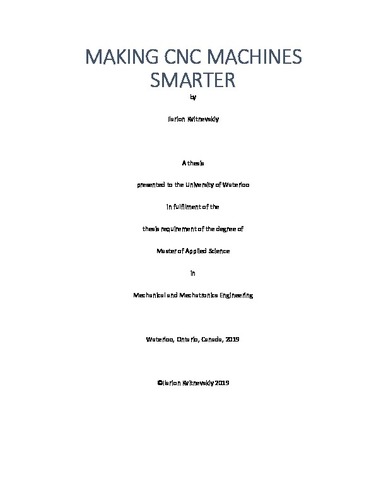| dc.contributor.author | Kvitnevskiy, Ilarion | |
| dc.date.accessioned | 2019-12-16 20:39:56 (GMT) | |
| dc.date.available | 2019-12-16 20:39:56 (GMT) | |
| dc.date.issued | 2019-12-16 | |
| dc.date.submitted | 2019-11-27 | |
| dc.identifier.uri | http://hdl.handle.net/10012/15327 | |
| dc.description.abstract | CNC machines are a commonly used manufacturing tool. Over the years, they have become increasingly sophisticated. While there is a lot of research into making the machines more sophisticated, there is little research into making the machines smarter. CNC machines lack any intelligence to make decisions. Making a system fully intelligent is extremely difficult to do in one step. This thesis will focus on small steps that will hopefully lead to an intelligent CNC machine.
The thesis first explores using audio data for perceiving the cutting state of the machine. Experienced machinist can listen to the machine and determine how it is cutting and can assess changes for improving the cutting rate or surface finish. Ideally, the machine should be able to determine how it is cutting and use that information to adjust machine parameter for a cutting goal. In this project, a neural network was trained to detect the presence of chatter. Unlike conventional methods, this project involved only doing a Fourier transform of the audio data. The neural network had success in identifying chatter in the audio data in all the cases that were tested.
Next the thesis explores incorporating a model of the cutting process and using it to generate its own toolpaths. This method involves using a cutting model that uses 2D pixels for determining the cut and uncut area. Using this model, a tool path is generated by optimizing each step to achieve an optimal cutting goal. Further, constraints are added to the optimization, which improve the toolpath by limiting the turning radius, which makes the path smoother. The result is a toolpath that maintains a consistent cutting force, and smooth turning.
The previous project relied on a simplified model of the cutting process. As CNC machines become smarter, they will need to have more accurate models of the process. Part of this would be to have accurate dynamic models of the machine. The last project focuses on building an automated device for capturing such models. This device uses a novel approach compared to traditional tap testing. The devices uses a voice coil for actuation, a load cell for force measurement, and a laser displacement for measuring the vibrations. This allows the tap tester to be able to measure many different tools without manually attaching accelerometers to each tool manually. | en |
| dc.language.iso | en | en |
| dc.publisher | University of Waterloo | en |
| dc.subject | cnc | en |
| dc.subject | automation | en |
| dc.subject | tap testing | en |
| dc.subject | neural network | en |
| dc.subject | chatter detection | en |
| dc.subject | toolpath | en |
| dc.title | Making CNC Machines Smarter | en |
| dc.type | Master Thesis | en |
| dc.pending | false | |
| uws-etd.degree.department | Mechanical and Mechatronics Engineering | en |
| uws-etd.degree.discipline | Mechanical Engineering | en |
| uws-etd.degree.grantor | University of Waterloo | en |
| uws-etd.degree | Master of Applied Science | en |
| uws.contributor.advisor | Bedi, Sanjeev | |
| uws.contributor.advisor | Mann, Stephen | |
| uws.contributor.affiliation1 | Faculty of Engineering | en |
| uws.published.city | Waterloo | en |
| uws.published.country | Canada | en |
| uws.published.province | Ontario | en |
| uws.typeOfResource | Text | en |
| uws.peerReviewStatus | Unreviewed | en |
| uws.scholarLevel | Graduate | en |

